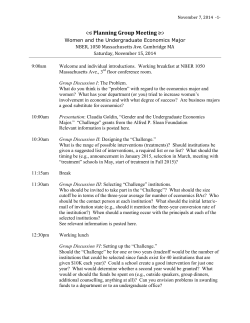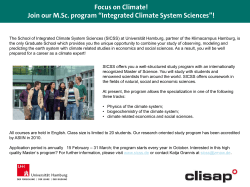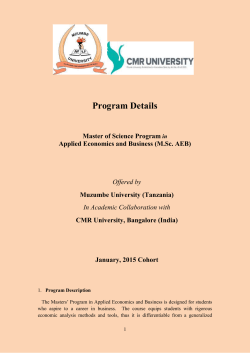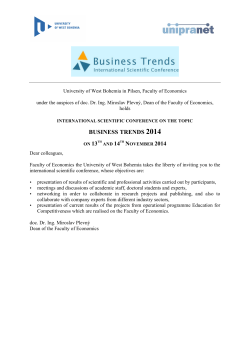
R E S E A R C H A T T H E B A N K O F ITA LY
Forthcoming events Latest working papers Latest occasional papers Workshops and conferences Selection of journal articles and books Useful links 1 2 3 9 14 15 21 Highlights DIRECTORATEGENERALFORECONOMICS,STATISTICSANDRESEARCH RESEARCHATTHEBANKOFITALY NUMBER 37 DECEMBER 2014 Contents Highlights 17th Central Bank Macroeconomic Modelling Workshop on “New Perspectives on Models for Policy Analysis” (Rome,20-21October2014) O n 20 and 21 October 2014 the Bank of Italy hosted the 17th annual “Central Bank Macroeconomic Modelling Workshop”. The workshop brings together policy-makersandacademicstodiscusscriticalissuesrelatedtotheclassofmodels usedforpolicyanalysis.Thisyear’sedition,entitled“NewPerspectivesonModels for Policy Analysis”, focused on the need to enrich structural models in order to accountinparticularforthe(possiblynon-linear)interactionbetweenthe0inancial sectorandtherealeconomy(inclosedandopeneconomiesandunderlowandhigh uncertainty)andforsystemicrisk. ________________________________ ________________________________________________________________ ______________________________________ ______________________________________ ______ 60th Economic Policy Panel (Rome,24-25October2014) On24and25October,theEinaudiInstituteforEconomicsandFinancehostedthe “60th Economic Policy Panel”.Themeetingwasjointlyorganizedbytheeditorsof EconomicPolicy,CEPRandtheBankofItaly.Paperscommissionedforthejournal werepresentedanddiscussedbythemembersofthePanel. Theprogrammeisavailablehere. ________________________________ ________________________________________________________________ ______________________________________ ______________________________________ ______ Conference on "Competition, Markets and Growth in Italy: the Long Term” (Rome,29-30October2014) W hat does history teach us about the relationship between competition and growth? How has competition helped shape the Italian economy? These issuesweredealtwithattheconference“Competition,MarketsandGrowthinItaly: the Long Term”, held at the Bank of Italy in Rome on 29 and 30 October. After a descriptionoftheEuropeanframeworkandcompetitionmeasures,theparticipants focused on Italy, examining a number of areas, including cultural questions. The evolution of competition in Italy was investigated at both aggregate and sectoral level, in order to provide a point of departure for policy analysis, which was the topicoftheconcludingdiscussion. Theprogrammeandthepapersareavailablehere. 1 RDEDFGHIFJJIDBFKLMNIJFOP-NDQEODJJDG NRSTDG37,DDHDSTDG2014 Highlights Conference on “The impact of the crisis on potential output and households’ expenditure in Italy “ (Rome,5December2014) O n 5 December 2014 the Bank of Italy hosted a conference entitled “The impact of the crisis on potential output and households’ expenditure in Italy”, presenting the 0indings of a research project carried out by economists at the Directorate General for Economics, Statistics and Research. The papers describe theimpactof thecrisison key macroeconomic variablesandseek to determine whether the cyclical downturn has caused structural changes in the behaviour of households and 0irms. This knowledge is crucial to projecting the timing and strength of the recovery and to policy design.A0irstsetofstudiesanalyzedtherepercussionsofthecrisisintermsoflossinpotentialoutput and lower capacity utilization, at aggregate and sectoral level. Two other papers documented the dismalperformanceofconsumptioninthelastfewyearsandexploredhowfarthismayrepresenta fallinpermanentincome.Freshempiricalevidenceonhowthecrisishasaffected0irms’price-setting policies and on the increased sensitivity of consumer in0lation to cyclical slackness was presented. Lastly,apaperassessedwhetherthesharpcyclicaldeteriorationofthelabourmarkethasgenerated structuralunemployment.Inaconcludingroundtable,thepanelistsmovedfromtheevidenceprovided to debate the macroeconomic and structural policies that are needed to foster a gradual recovery towardsfastergrowth ________________________________ ________________________________________________________________ ____________________________________ ____ ____________________________________ Workshop on Macroeconomic Dynamics: Theory and Applications (Rome,19December2014) O n 19 December the Einaudi Institute for Economics and Finance hosted the 13th edition of the “WorkshoponMacroeconomicDynamics:TheoryandApplications”.Researchersworkingonissues intheoreticalandapplieddynamicmacroeconomicsdiscussedpioneeringpapersandresearchprojects. Theprogrammeisavailablehere. Forthcoming events 4nations cup (Rome,8May2015) The next edition of the “4nations cup” will be held on 8 May 2015 at the Einaudi Institute for EconomicsandFinance.Thecupisaone-daycontestamongthemostpromisingyoungscholarsinfour countriesinthe0ieldof0inancialeconomics.Itconsistsinaseriesof40-minute“shortseminars”.Inthe 2015 edition, the contestants will come from universities in Denmark, Italy, Sweden and the United Kingdom Furtherinformationisavailablehere. S9:;<=>? =@ @A9 B=<B CD I@=EF S9:;<=>? =@ EIEF 2 RDEDFGHIFJJIDBFKLMNIJFOP-NDQEODJJDG NRSTDG37,DDHDSTDG2014 Latest working papers No.997: Macroeconomic effects of simultaneous implementation of reforms after the crisis (November2014) No.995: Dynasties in professions: the role of rents (November2014) SauroMocetti T hecorrelationbetweenthesocio-economic statusofparentsandtheiroffspringhas emergedasoneofthestylizedfactsineconomics, thoughcross-countryandcross-occupation variationisremarkable.However,partofthe underlyingmechanismbehindintergenerational persistenceremainstobeexplained.Thispaper contributestotheexistingliteraturebyproviding evidenceontheroleofrents–(unfair)economic bene0itsthatindividualsobtainasadultsbecause oftheirparents’professionalposition.Several identi0icationstrategies,includingtheexploitation ofdiscontinuitiesinregulation,suggestthatrents signi0icantlyaffectchildren’spropensitytofollow theirparents’professionalcareerpaths.Froma policyperspective,theremovalofanti-competitive regulationandotherpositionaladvantagesmay increasebothsocial0luidityandlabormarket ef0iciency. Fulltext(pdf) AndreaGerali,AlessandroNotarpietroand MassimilianoPisani T hispaperevaluatesthemacroeconomic effectsofsimultaneouslyimplementing0iscal consolidationandcompetition-friendlyreformsin acountryoftheeuroareabysimulatingalargescaledynamicgeneralequilibriummodel.We0ind, 0irst,thatthejointimplementationofreformshas additionalexpansionaryeffectsonlong-run economicactivity.Increasingcompetitioninthe servicesectorfavorsahigherincometaxbase. Giventhetargetedpublicdebt-to-GDPratio,labor andcapitalincometaxratescanbereducedmore thanwith0iscalconsolidationalone.Second,0iscal consolidationhasnon-negligiblemedium-run costs;however,theyarereducedbyjoint implementationwiththeservicesreform.The resultsarerobusttoalternativeassumptionsthat capturetheimpactof0inancialcrisisonthe 0inancingconditionsofhouseholds. Fulltext(pdf) No.994: Trade Liberalization and Domestic Suppliers: Evidence from Chile (November2014) No.996: Current account “core-periphery dualism” in the EMU (November2014) AndreaLinarello TatianaCesaroniandRobertaDeSantis C urrentaccount(CA)dispersionwithinEuropean Union(EU)memberstateshasbeenincreasing progressivelysincethe1990s.Interestingly,the persistentde0icitsinmanyperipheralcountrieshave notbeenaccompaniedbyasigni0icantgrowth processabletostimulatealogrunrebalancingas neoclassicaltheorypredicts.Toshedlightonthe issuethispaperinvestigatesthedeterminantsof EurozoneCAimbalances,focusingontheroleplayed by0inancialintegration.Theanalysisconsiderstwo samplesof22OECDand15EUcountries,threetime horizonscorrespondingtovariousstepsinEuropean integration,differentcontrolvariablesandseveral paneleconometricmethods.Theresultssuggestthat withintheOECDandEUgroups0inancialintegration contributedtoexplainCAdeteriorationinthe peripheralcountriesespeciallyinthepost-EMU period.Thebusinesscycleseemstohaveplayeda growingroleovertime,whereastheroleof competivenessseemstohavediminishedwith respecttothepast.Fulltext(pdf) 3 I examinetheeffectofreducingexporttariffson theproductivityofdomesticsuppliersof exporting0irms.UsingapanelofChilean0irms duringaperiodoftradeliberalizationwiththe EuropeanUnion,theUnitedStates,andthe RepublicofKorea,Ishowthattheaverage reductionintheexporttariffofdownstream industries(1.1percentagepoints)increasesthe productivityofintermediateinputsuppliersby1.5 percent.Theincreaseinproductivityamong domesticsuppliersaccountsfor22.5percentof aggregateproductivitygains.I0indthattariffcuts induce0irmstoacquirenewmachineryandpay higherwagestoskilledworkers.These0indings areconsistentwithasimplemodelinwhichlower exporttariffsincreasethesalesofexporting0irms andincreasethederiveddemandfor intermediatesthroughinput-outputlinkages. Fulltext(pdf) RDEDFGHIFJJIDBFKLMNIJFOP-NDQEODJJDG NRSTDG37,DDHDSTDG2014 Latest working papers fundamentals,whicharepickedasscapegoatsto rationalizeobservedcurrency0luctuationsattimes whenexchangeratesaredrivenbyunobservable shocks.Usingnovelsurveydatathatdirectly measureforeignexchangescapegoatsfor12 exchangerates,we0indempiricalevidencethat supportsthescapegoattheory.Theresulting modelsexplainalargefractionofthevariationand directionalchangesinexchangeratesinsample, althoughtheirout-of-sampleforecasting performanceismixed. Fulltext(pdf) No.993: Optimal monetary policy rules and house prices: the role of Jinancial frictions (October2014) AlessandroNotarpietroandStefanoSiviero W eprobethescopeforreactingtohouse pricesinsimpleandimplementable monetarypolicyrules,usingaNewKeynesian modelwithahousingsectorand0inancialfrictions onthehouseholdside.Weshowthatthesocial welfaremaximizingmonetarypolicyrulefeatures areactiontohousepricevariations,whenthe latteraregeneratedbyhousingdemandor 0inancialshocks.Thesignandsizeofthereaction cruciallydependonthedegreeof0inancial frictionsintheeconomy.Whentheshareof constrainedagentsisrelativelysmall,theoptimal reactionisnegative,implyingthatthecentralbank mustmovethepolicyrateintheopposite directionwithrespecttohouseprices.However, whentheeconomyischaracterizedbya suf0icientlyhighaverageloan-to-valueratio,then itbecomesoptimaltocounterhouseprice increasesbyraisingthepolicyrate. Fulltext(pdf) No.990: How much of bank credit risk is sovereign risk? Evidence from the Eurozone (October2014) JunyeLiandGabrieleZinna W edevelopamultivariatecreditriskmodel forthetermstructuresofsovereignand bankcreditdefaultswaps.First,weseparatethe probabilityofjointdefaultsoflargeEurozone sovereigns(systemicrisk)fromthatofsovereignspeci0icdefaults(countryrisk).Then,wequantify individualbanks'exposurestoeachtypeof sovereignrisk,aswellasbank-speci0iccreditrisk. Banks’sovereignriskexposuresvarywithbanks’ size,theirholdingsofsovereigndebt,andexpected governmentsupport.Onaverage,45%ofFrench andSpanishbanks'creditriskconsistsin sovereignrisk,comparedwithonly30%forItalian and23%forGermanbanks.Furthermore,short- tomedium-termcontractsareparticularly informativeonsovereignsystemicrisk. Fulltext(pdf) No.992: Informed trading and stock market efJiciency (October2014) TaneliMäkinen T heinformationcontentofstockpricesis analysedwithoutimposingstrongrestrictions ontraders'preferencesandthedistributionof dividends.Noiseintheinformationcontainedin equilibriumpricesarisesfromendogenousasset supply,whichoffsetspricemovementsdueto informedtrading.Theinformativenessofstock pricesincreaseswiththewealthoftheinformed tradersanddecreaseswiththerisk-freerate,as stockpricesrespondmorestronglytoinformation heldbyinformedtraderswhentheytakelarger positionsinstocks. Fulltext(pdf) No.989: The determinants of household debt: a cross-country analysis (October2014) MassimoColetta,RiccardoDeBonisandStefano Piermattei I nmostcountrieshouseholddebtincreasedfrom the1990suntilthecrisisof2007-2008before stabilizingduetorecessionanddeleveraging. However,therearenationaldifferencesin householddebt/GDPratios.Thispaperstudiesthe determinantsofhouseholddebt,usinga32countrydatasetandtakingbothdemand-sideand supply-sidefactorsintoaccount.Theeconometric exercises,coveringtheperiod1995-2011,yield twomainresults.First,debtisgreaterincountries No.991: The scapegoat theory of exchange rates: the Jirst tests (October2014) MarcelFratzscher,Dag.innRime,LucioSarnoand GabrieleZinna T hescapegoattheoryofexchangerates (BacchettaandvanWincoop2004,2013) suggeststhatmarketparticipantsmayattach excessiveweighttoindividualeconomic 4 RDEDFGHIFJJIDBFKLMNIJFOP-NDQEODJJDG NRSTDG37,DDHDSTDG2014 Latest working papers withhigherpercapitaGDPandhouseholdwealth. Second,theef0icacyofbankruptcylawsis correlatedwiththelevelofhouseholddebt,while alongertimetoresolveinsolvenciesisassociated withlowerdebt.Thesetwoinstitutionalvariables arelinkedtohouseholddebtmorerobustlythanis thequalityofcreditregisters. Fulltext(pdf) arepositivelyrelatedtothelevelofentrepreneurs’ leverage,re0lectingthefactthathigherleverage impliesgreaterelasticityofthepolicyrateto changesinloanrates,whichinturnincreases banks’marketpower.Third,we0indthat ampli0icationisstrongerthemoreaggressivethe centralbank’sresponsetoin0lation,asmeasured bythein0lationcoef0icientintheTaylorrule. Fulltext(pdf) No.988: The interest-rate sensitivity of the demand for sovereign debt. Evidence from OECD countries (1995-2011) (October2014) No.986: An estimated DSGE model with search and matching frictions in the credit market (October2014) DaniloLiberati GiuseppeGrande,SergioMasciantonioandAndrea Tiseno F inancialfrictionshavebecomefundamental forstudyingthebusinesscycleandcredit marketdynamics.Thisworkaddstotheexisting literaturebyintroducingasearchandmatching schemeinthe0inancialmarketintoacashin advanceNewKeynesianDSGEtheoreticalmodel. Weprovideanalternativeexplanationofthe degreeofincompletenessinthepass-throughfrom policyratetoloanratesdependingoncredit markettightness,thesearchcostssustainedby banks,andtherelativepowersoftheagentsin loaninterestratebargaining.Themodelisableto reproducethecountercyclicalbehaviourofthe creditspreadwithrespecttoapositivetechnology shock.Italsoproposesascenarioinwhichacredit shockhitstheeconomy.Themodelisestimatedby usingtheBayesianprocedures.Finally,sincethere isstillsomedisagreementaboutthetheoretical mechanismbywhichtheinterestrateonloansis derived,wesurveyandcomparethesetheoretical deviceswiththatproposedbythispaper. Fulltext(pdf) P ublicdebtlevelsinadvancedeconomieshave increaseddramaticallyoverrecentyearsand theycouldputconsiderableupwardpressureon marketyields.Usinganovelidenti0ication approachbasedon0inancialaccountsandfocusing onpanelregressionsfor18advancedeconomies overtheperiod1995–2011,thispaperestimates thelong-termslopeofthedemandfunctionfor governmentsecuritiesinareduced-formsetting. We0indthatpublicdebtdoesmatter:each percentagepointincreaseinthepublicdebtto GDPratioraises10-yearratesbyabout2basis points.Thepotentialdragonpublicdebt sustainabilitycausedbythefeedbackloopof publicdebtonhigherinterestratesshouldnot thereforebeoverlooked. Fulltext(pdf) No.987: Large banks, loan rate markup and monetary policy (October2014) VincenzoCucinielloandFedericoM.Signoretti No.985: Dif-in-dif estimators of multiplicative treatment effects (October2014) T hispaperstudiestheimplicationsof introducinglargemonopolisticbanks,which canaffectmacroeconomicoutcomesandthusthe responseofmonetarypolicytoin0lation,ina modelwithacollateralconstraintlinkingthe borrowers’creditcapacitytothevalueoftheir durableassets.First,we0indthatstrategic interactiongeneratesacountercyclicalloan spread,whichampli0iestheimpactofmonetary andtechnologyshocksontherealeconomy.This typeof0inancialacceleratoraddsuptotheone dueto0inancialfrictionsandiscruciallyrelatedto theexistenceofnon-atomisticbanks.Second,the levelofthespreadandthedegreeofampli0ication EmanueleCianiandPaulFisher W econsideradifference-in-differences settingwithacontinuousoutcome,suchas wagesorexpenditure.Thestandardpracticeisto takethelogarithmoftheoutcomeandthen interprettheresultsasanapproximationofthe multiplicativetreatmenteffectontheoriginal outcome.Wearguethataresearchershould insteadfocusontheoriginaloutcomewhen discussingcausalinference.Furthermore,itis preferabletouseanon-linearestimator,because 5 RDEDFGHIFJJIDBFKLMNIJFOP-NDQEODJJDG NRSTDG37,DDHDSTDG2014 Latest working papers runningOLSonthelog-linearisedmodelmight confounddistributionalandmeanchanges.We illustratetheargumentwithanoriginalempirical analysisoftheimpactoftheUKEducational MaintenanceAllowanceonhouseholds' expenditure,andwithasimulationexercise. Fulltext(pdf) innovatecomparedwithexternalcounterparts. Fulltext(pdf) No.982: Informational effects of monetary policy (October2014) GiuseppeFerrero,MarcelloMiccoliandSergio Santoro W No.984: Natural expectations and home equity (October2014) RobertoPancraziandMarioPietrunti I nthispaperweshowthatlong-runexpectations aboutfuturehousingpricesofbothhouseholds and,especially,0inancialintermediarieshada largeimpactonhouseholds'indebtednessduring therecentboominU.S.housingprices.We introducethetheoryofnaturalexpectationsina collateralizedcreditmarketmodelpopulatedby householdsandbanksand0ind:(1)thatmild variationsinlong-runforecastsofhousingprices resultinlargedifferencesintheamountofhome equityextractedduringtheboom;and(2)thatthe equilibriumlevelofdebtandtheinterestrateare particularlysensitiveto0inancialintermediaries' naturalness. Fulltext(pdf) No.983: Science and Technology Parks in Italy: main features and analysis of their effects on the Jirms (October2014) eanalyseasimpli0iedNew-Keynesian modelwithanunobservedaggregatecostpushshockinwhich0irmsandthecentralbank havedifferentinformationabouttheshock.We consideralinearpolicyrulewhereapurein0lation targetingcentralbankdecideshowmuchtoreact totheshockgivenitsinformation.Inthis frameworkweshowthatmonetarypolicy performsbothanallocationalandan informationalrole,thelatterdueto0irms extractinginformationontheaggregateshock fromthemonetarypolicytool.Whenthe informationalroleispresent,optimalmonetary policyismorecautious,thatis,itrespondslessto theshockthantheperfectinformationbenchmark. Amorecautiousreactiontotheshockimpliesthat 0irmsmakemoreeffectiveuseoftheirprivate informationandtheendogenousinformation comingfromtheaggregatepriceinordertomake inferencesabouttheshock. Fulltext(pdf) No.981: The academic and labor market returns of university professors (October2014) DaniloLiberati,MarcoMarinucciandGiulia MartinaTanzi W eanalysetheresultsofasurveyconducted bytheBankofItalyinthespringof2012 onItalianscienceandtechnologyparks.Firstwe describethemainfeaturesofscienceparksin Italy.Thenweinvestigatewhethertheyhave beeneffectiveinimprovingtheeconomic performanceandinnovativecapacityofthe0irms locatedwithinthem.We0indapronounced heterogeneitybetweenscienceandtechnology parks,whosecooperationwithpublicresearch institutionsischaracterizedbyphysical proximity.Althoughthebusinesssituationof 0irmslocatedinscienceandtechnologyparks tendsonaveragetobebetterthanthatofsimilar “non-park”0irms,adifference-in-differences estimationshowsthatenteringascienceand technologyparkdidnotgenerallyimprove0irms’ businessperformanceandtheirpropensityto 6 MicheleBraga,MarcoPaccagnellaandMichele Pellizzari T hispaperestimatestheimpactofuniversity teachersontheirstudents’academic achievementandlabormarketoutcomesusing administrativedatafromBocconiUniversity matchedwithItaliantaxrecords.Theestimation exploitstherandomallocationofstudentsto teachersina0ixedsequenceofcompulsory courses.We0indthattheacademicandlabor marketreturnsofteachersareonlymildly positivelycorrelatedandthattheprofessorswho arebestatimprovingtheacademicachievement oftheirbeststudentsarenotalwaysalsotheones whoboosttheirstudents’earningsthemost, especiallyfortheleastablestudents. Fulltext(pdf) RDEDFGHIFJJIDBFKLMNIJFOP-NDQEODJJDG NRSTDG37,DDHDSTDG2014 Latest working papers No.980: Sharing information on lending decisions: an empirical assessment (October2014) UgoAlbertazzi,MargheritaBotteroandGabriele Sene W epresentthe0irstempiricalstudyof informationspilloverandsignallingonloan searchanditsoutcomesinasettingwhereabank observeswhetheraloanapplicanthasalready beenrejectedbyotherlenders.Wedosobytaking advantageofthefactthatItaly’sCentralCredit Registerdisclosessuchinformation.Theresults showthatdisclosinginformationonpast rejectionsnegativelyaffectstheprobabilityof continuingaloansearch.Atthesametime,the informationonformerrejectionsisassociated withahigherprobabilityofbeingfundedfor borrowerswhoarenotdiscouragedandcontinue thesearch,providedtheyarenotopaque.Withthe aidofatheoreticalmodel,weshowthatbanks interprettheinformationonpreviousrejectionsas asignalofunobservablequalityfortheaverage borrowerbutnotformoreopaqueborrowers, whosepastrejectionsnegativelyaffectthe outcomeoflaterapplications.Wealsoshowthat banksdifferintheextenttowhichtheyrelyonthis information,inawaythatatleastpartlyre0lects thedifferentinformationalcontentthatthissignal carriesforthem. Fulltext(pdf) No.979: Quantile aggregation of density forecasts (October2014) FabioBusetti Quantileaggregation(or'Vincentization')isa simpleandintuitivewayofcombining probabilitydistributions,originallyproposedby S.B.Vincentin1912.Incertaincases,suchas underGaussianity,theVincentizeddistribution belongstothesamefamilyasthatofthe individualdistributionsandcanbeobtainedby averagingtheindividualparameters.Thispaper comparesthepropertiesofquantileaggregation withthoseoftheforecastcombinationschemes normallyadoptedintheeconometricforecasting literature,basedonlinearorlogarithmic averagesoftheindividualdensities.Ingeneralwe 0indthat:(i)largerdifferencesamongthe combinationschemesoccurwhenthereare biasesintheindividualforecasts,inwhichcase quantileaggregationseemspreferableoverall; 7 (ii)thechoiceofthecombinationweightsis importantindeterminingtheperformanceofthe variousmethods.MonteCarlosimulation experimentsindicatethatthepropertiesof quantileaggregationfallbetweenthoseofthe linearandthelogarithmicpool,andthatquantile averagingisparticularlyusefulforcombining forecastdistributionswithlargedifferencesin location.Anempiricalillustrationisprovided withdensityforecastsfromtimeseriesand econometricmodelsforItalianGDP. Fulltext(pdf) No.978: Does issuing equities help R&D activity? Evidence from unlisted Italian high-tech manufacturing Jirms (October2014) SilviaMagri T hispaperevaluatesthecausaleffectofissuing equitiesontheprobabilitythata0irmwill engageinR&Dactivity.Equityisapreferable sourceofexternal0inanceforinnovationthan debt.Itdoesnotrequirecollateral,doesnot exacerbatemoralhazardproblemsconnectedwith thesubstitutionofhigh-riskforlow-riskprojects, quitecommonwhenusingdebt,and,unlikedebt, doesnotincreasetheprobabilityofbankruptcy; equityalsoallowsinvestorstoreaptheentire bene0itofreturnsonsuccessfulinnovative projects.Thepaperfocusesonhigh-tech0irmsfor whichasymmetricinformationproblemsaremore pervasive.Implementinganinstrumentalvariable estimation,we0indthatissuingequityincreases theprobabilityofthe0irmmakingR&D expenditureby30-40percent.Wedetect considerableheterogeneityacross0irms:the impactofissuingequityissigni0icantonlyfor small,young,andmorehighlyleveraged0irms.We also0indinterestingevidencethatissuingequity increasesR&Dexpenditureinrelationtosales. Fulltext(pdf) No.977: Financial indicators and density forecasts for US output and inJlation (October2014) PiergiorgioAlessandriandHaroonMumtaz W hendo0inancialmarketshelpinpredicting economicactivity?Withincomplete markets,thelinkbetween0inancialandreal economyisstate-dependentand0inancial RDEDFGHIFJJIDBFKLMNIJFOP-NDQEODJJDG NRSTDG37,DDHDSTDG2014 Latest working papers indicatorsmayturnouttobeusefulparticularly inforecasting"tail"macroeconomicevents.We examinethisconjecturebystudyingBayesian predictivedistributionsforoutputgrowthand in0lationintheUSbetween1983and2012, comparinglinearandnonlinearVARmodels.We 0indthat0inancialindicatorssigni0icantly improvetheaccuracyofthedistributions.Regime -switchingmodelsperformbetterthanlinear modelsthankstotheirabilitytocapturechanges inthetransmissionmechanismof0inancial shocksbetweengoodandbadtimes.Suchmodels couldhavesentacredibleadvancewarning aheadoftheGreatRecession.Furthermore,the discrepanciesbetweenmodelsarethemselves predictable,whichallowstheforecasterto formulatereasonablereal-timeguessesonwhich modelislikelytobemoreaccurateinthenext future. Fulltext(pdf) Other recent working papers September 2014 July 2014 No. 976:Multidimensionalpovertyand inequality RolfAabergeandAndreaBrandolini No. 975:HedonicvalueofItaliantourism supply:comparingenvironmentaland culturalattractiveness ValterdiGiacintoandGiacintoMicucci No. 974:Identi0icationandestimationof outcomeresponsewithheterogeneous treatmentexternalities TizianoArduini,EleonoraPatacchiniand EdoardoRainone No. 973:Inequalityandtrust:newevidence frompaneldata GuglielmoBaroneandSauroMocetti No. 972:Aresovereignwealthfunds contrarianinvestors? AlessioCiarloneandValeriaMiceli No. 971:Randomswitchingexponential smoothingandinventoryforecasting GiacomoSbranaandAndreaSilvestrini No. 970:Academicperformanceandthegreat recession EffrosyniAdamopoulouandGiuliaMartina Tanzi No. 969:Stockmarketef0iciencyinChina: evidencefromthesplit-sharereform AndreaBeltratti,BernardoBortolottiand MariannaCaccavaio No. 968:PricepressuresintheUKindexlinkedmarket:anempirical investigation GabrieleZinna No. 967:Measuringspatialeffectsinpresence ofinstitutionalconstraints:thecaseof ItalianLocalHealthAuthorityexpenditure VincenzoAtella,FedericoBelotti,Domenico DepaloandAndreaPianoMortari No. 966:Bankbonds:size,systemicrelevance andthesovereign AndreaZaghini No. 965:Behindandbeyondthe (headcount)employmentrate AndreaBrandoliniandElianaViviano No. 964:Foreignexchangereserve diversi0icationandthe"exorbitant privilege" PietroCova,PatrizioPaganoand MassimilianoPisani 8 RDEDFGHIFJJIDBFKLMNIJFOP-NDQEODJJDG NRSTDG37,DDHDSTDG2014 Latest occasional papers No.254:A feasible unemployment-based shock absorber for the euro area (November2014) theseindicestoselectedcon0igurationsofthe parameterstomakecross-countrycomparisons. Fulltext(pdf) AndreaBrandolini,FrancescaCartaandFrancesco D’Amuri No.252:DeJlationary shocks and de-anchoring of inJlation expectations (November2014) T hispapercontributestothedebateonthe designofacentralised0iscaltoolabsorbing country-speci0icnegativeshocksintheeuroarea. Basedontheoreticalinsights,itidenti0iesthe broadcharacteristicsthatashockabsorber basedonunemploymentshouldhaveinorderto beincentive-compatibleandpoliticallyfeasible. Itthenderivesempiricallythecombinationof activationthresholds,experiencerating, eligibilitycriteria,andbene0itgenerositywhich de0inethesystemsofferingthehighest stabilisationforgivenlevelsofredistribution, accountingforthelargevariationinbene0ittakeupratesacrossEuropeancountries.Theanalysis suggeststhattheshockabsorbershould:i)give risetomacrocross-nationaltransfers,mimicking thosethatwouldbegeneratedbyanotional euro-wideunemploymentbene0itschemeof minimalcoverageandgenerosity;ii)beactivated byatrigger;andiii)featurepartialexperience rating.Thesimulationresults,con0irmedby robustnesschecks,showthatevensystemsthat donotredistributeresourcesbetweencountries canhaveaconsiderablestabilisationimpactin themediumrun.Lowbene0ittake-upinSouthern Europesubstantiallyreducesthestabilisation propertiesandthesizeofthescheme. Fulltext(pdf) No.253:Accounting for total work (November2014) AndreaBrandoliniandElianaViviano W eanalysehowaccountingforhousehold productioncouldaffectlabourmarket statistics.Thistopichasgrowninimportance sincethereleaseofthenewSystemofNational Accountsin2008.Becausethetraditional headcountratiosfocussingonthenumberof peoplecarryingoutsomehomeandsomemarket productionmaynotbeveryinformative,we proposeageneralclassofindicesbasedonthe timespentoneachtypeofworkthat encompassesheadcountindicators.Weapply 9 FabioBusetti,GiuseppeFerrero,AndreaGeraliand AlbertoLocarno A prolongedperiodoflowin0lationcan heightentheriskofin0lationexpectations de-anchoringfromthecentralbank’sobjective, particularlywhenmonetarypolicyratesare nearthezerolowerbound.Thispaper investigatestheeffectsofasequenceof de0lationaryshocksonexpected/realized in0lationandoutput.Todosoweconsidera simpleNewKeynesianmodelwhereagentshave incompleteinformationabouttheworkingof theeconomyandformexpectationsthroughan adaptivelearningprocess(inthesensethat theybehavelikeeconometricians,using regressionstoanticipatethefuturevalueofthe variablesofinterest).Themodelissimulated witheuroareadataovertheperiod2014-16 underassumptionsofbothrationalexpectations andlearning.Themain0indingsarethe following:(i)underlearning,pricedynamicsin 2015-16is0.6percentagepointsloweron averagethaninthecaseoffullyrationalagents, asin0lationexpectationsarestronglyaffected byrepeatedde0lationaryshocks;(ii)the learningprocessimpliesa(data-driven)deanchoringofin0lationexpectationsfromthe centralbank’starget,whichwouldbeperceived byeconomicagentstofallto0.8percentatthe endof2016;(iii)outputexpectationswould alsobelowerinthecaseoflearning,resultingin aslowerrecoveryofeconomicactivity. Fulltext(pdf) No.251:Do Jirm-bank relationships affect Jirms’ internationalization? (November2014) RiccardoDeBonis,GiovanniFerriandZenoRotondi T hegoalofthispaperistoinvestigatethelink betweenthelengthofa0irm-bankrelationship and0irm’sinternationalization.Theanalysisis carriedoutonmatched0irm-bankmicro-datafrom RDEDFGHIFJJIDBFKLMNIJFOP-NDQEODJJDG NRSTDG37,DDHDSTDG2014 Latest occasional papers asurveyofItalianenterprisesfrom1998to2003. Weobtaintwomainresults.First,alonger relationshipwiththemainbankfosters0irms’ foreigndirectinvestment(FDI)whileitdoesnot affecttheexportstatusoftheenterprisesnot engaginginFDI.Second,theprobabilityofa0irm undertakingFDIfurtherincreasesifitsmainbank isitselfinternationalizedbyholdingforeign subsidiaries.Fulltext(pdf) ariseforItalian0irms.Projectswillbeassessedby lookingbeyondtheinitialbidprice:qualityand life-cyclepro0itabilitywillbemorerelevant, representingapotentialadvantagetoItalian0irms usedtomanaginglarge,complexprojects.Onthe otherhand,amorewidespreaduseofnational procurementprocedurescouldresultina comparativedisadvantagefornon-local0irms. Fulltext(pdf)inItalianonly No.250:Beyond the acronyms: local property taxation in Italy (November2014) No.248:Domestic and foreign sales: complements or substitutes? (November2014) GiovannaMessinaandMarcoSavegnago MatteoBugamelli,EugenioGaiottiandEliana Viviano T hepapertracesrecentdevelopmentsinlocal realestatetaxationinItaly.Weexploitarich datasetatbothaggregateandindividuallevelto estimatethevariationinlocaltaxeson0irsthomes inthelastthreeyearsandtheredistributiveimpact oftheadoptionofthetaxonindivisibleservicesin 2014.Localpropertytaxeson0irsthomesaverage one0ifthlowerin2014thanin2012;including wastedisposaltaxes,theoveralllocal0iscalburden remainsbroadlystable.However,taxationbears moreheavilyonlower-incomehouseholds,owingto decreasedallowancefortaxdeductions.To conclude,thepaperexaminespossiblefuturelocal propertytaxreformmeasures(keepingtotal revenueconstant)toenhancetransparencyand equity.Fulltext(pdf)inItalianonly No.249:The World Bank’s procurement competition and the Italian construction industry (November2014) MicheleBenvenuti,LucaCasolaro,TindaroPaganini andUmbertoViviani T heWorldBank’sprocurementsector performsyearlyoperationsrangingfrom$20 to$40billion,halfofwhich0inancingcivilworks. TheshareofcontractsassignedtoItalian0irms peakedat4percentin2007-2012(6percentin thecivilworkssector),signi0icantlyimprovingthe leveloftheprevious2001-2006period;Italy rankedasthefourthcountryinoverallvalue. Theseprojectsarecarriedoutbyasmallnumber of0irms,arelargeinsize,situatedinrelatively closemarkets(EasternEuropeandCentralAsia) andmainlyrelatedtotransportation.TheWorld Bank’sprocurementproceduresarecurrently underrevision.Bothopportunitiesandrisksmay 10 H owarethedynamicsofforeignanddomestic salescorrelatedatthe0irmlevel?The questionisrelevantinthatthesignofthe correlationshapestheinternationaltransmission ofshocksandtheeffectsofpolicymeasures.From atheoreticalperspective,thecorrelationcouldbe eitherzero,asassumedbystandardinternational trademodels,ornegativeif0irmsarecapacity constrained,orpositiveifliquidityconstraints dominate.Theempiricalevidence,however,is rathermixed.UsingasampleofItalian manufacturing0irmsintheperiod2001-12,we showthat:i)thesignofthecorrelationchanges overthebusinesscycle,beingnegativeinthe0irst partofthepastdecadeandpositiveafterthe2008 crisis;ii)allthechannelssuggestedbythe literatureareinvolvedandtheymayexplainthe time-varyingcorrelation;iii)thedropindomestic salesbyItalian0irmsin2012,contributed negativelyto0irms’exports,andtogetherwith liquidityconstraints,thefallreducedthegrowth rateofexportsbyanaverageof0.6percentage points.Fulltext(pdf) No.247:How the labour market evaluates Italian universities (November2014) EmanueleCianiandVincenzoMariani W eanalysehowthelabourmarketimplicitly evaluatesItaly’shighereducationsystemby estimatingdifferencesinemploymentand earningsacrossuniversities.Weuseourestimates toproducethreerankingsofuniversitiesbased, respectively,onemployment,earningsand employment-weightedearnings.Bycontrollingfor alargesetofcovariates,weisolateeachuniversity RDEDFGHIFJJIDBFKLMNIJFOP-NDQEODJJDG NRSTDG37,DDHDSTDG2014 Latest occasional papers effectonemploymentandearningsfrom additionalcomponentsin0luencinggraduates' labourmarketoutcomes,namelytheuniversity’s 0ieldofspecialization,thegraduates'observable characteristicsandtheirlocallabourmarkets.To accountforthelatter,weincludegraduates' employmentrateintheregionofresidenceamong thecovariatesbutweinstrumentitwithprior residenceinordertocorrectforendogenous sorting.Wediscussprosandconsofour methodologyandcompareourresultswithother availableuniversityrankings.Fulltext(pdf) No.246:Regional policies to foster Jirms’ innovation activity (November2014) FrancescaLottiandMariaLuciaStefani F ollowingtheconstitutionalreformof2001, whichgaveincreasedautonomyItalian regions,andthenewEuropeanguidelinesfrom theLisbonAgenda,therehasbeenanupturnin regionallegislativeactivityconcerninginnovation, leadingtoacriticalreviewoftheinstruments adopted,mainlytowardsgreaterselectivity. Regionalinterventiontendstobehighly fragmented,focusingonthefundingofapplied researchandusinggrantsasthepreferredpolicy tool.Intermsofsourcesoffunds,structuralfunds havegainedimportancesincethe2007-13 programmingcycle,partlyduetotheeconomic crisis,andinthesouthernregionsaccountfor nearlyalltheresourcesdevotedtofostering innovation.Thispaperpresentsasummary indicator,consistingofthree"sub-indicators" approximating,respectively,theinputofthe innovationprocess,innovationoutput,anda quantitativemeasureofregionalpoliciesfor innovation.Fulltext(pdf)inItalianonly No.245:Just round the corner? Pros, cons, and implementation issues of a Jiscal union for the euro area (November2014) FabrizioBalassone,SandroMomigliano,Marzia RomanelliandPietroTommasino T heexperienceofothersuccessfulmonetary unionsandeconomictheorysuggestthatthe euroareawouldbene0itfromtheestablishmentof asupranational0iscalcapacity.Institutional reformspromptedbythecrisis(e.g.,theEuropean 11 StabilityMechanismandthebankingunion)are introducing–thoughtoalimitedextent– elementsofcross-countryrisksharing. Nevertheless,furtherstepsareprobablyneeded. Proposalstocreateasortofrainy-dayfundpresent majorpracticaldif0iculties–associated,interalia,to theuncertaintycharacterizingtheidenti0icationof shocksinrealtime.Amoreappropriatesolution, consistentwithhowrisksharingoperatesin existingfederations,maybecentralizingspeci0ic publicfunctions(forinstance,byintroducinga commonunemploymentbene0itscheme).Weargue thatconsiderationcouldalsobegiventothe creationofaeuro-wide,notionalde0inedcontributionpensionscheme.Fulltext(pdf) No.244:The role of leverage in Jirm solvency: evidence from bank loans (October2014) EmiliaBonaccorsidiPatti,AlessioD’Ignazio,Marco GalloandGiacintoMicucci T hetworecessionsthathavehitItalysincethe endof2008haveraisedtheshareofnonperformingloanstobusinessesinbanks’ portfoliossubstantially.Inthispaperweevaluate towhatextentthedeteriorationofcreditquality wasduenotonlytothedeclinein0irms’sales duringthecontractionofeconomicactivity,butalso tothelevelof0irms’0inancialdebtattheonsetof the0irstrecession.Ourresultsshowthat,other thingsbeingequal,atenpercentagepointincrease inleverageisassociatedwithahigherprobabilityof defaultofalmostonepercentagepoint.Moreover, theadverseimpactofafallinsalesona0irm’s solvencyisalmostfourtimesgreaterfor0irmsin thehighestquartileoftheleveragedistribution thanfor0irmsinthe0irstquartile.These0indings con0irmthat0irms’0inancialstructurecanbea powerfulampli0ierofmacroeconomicshocks.A higherlevelofleveragereduces0irms’resilience duringarecession,andthisinturnweakensthe balance-sheetsofbanksandthustheirabilityto providecredit.Fulltext(pdf) No.243:Foreign direct investment and multinational Jirms (October2014) AlessandroBorinandRiccardoCristadoro S incetheearly1990sinternationalizationhas movedforwardveryrapidly.Withthe reorganizationofproductionprocessesonaglobal RDEDFGHIFJJIDBFKLMNIJFOP-NDQEODJJDG NRSTDG37,DDHDSTDG2014 Latest occasional papers scale,theaveragegrowthrateofforeigndirect investment(FDI)hasexceededthatofGDPand trade,anditsgeographicalandsectoral distributionhaschanged.In2012,forthe0irst timeFDI0lowstodevelopingcountriesoutpaced thosetodevelopedcountries.Italylagsbehindasa destinationforFDIin0lowsandalsoasan originatorofFDIout0lows.Theexpansionof Italianmultinationalsinthe'90swaslargely drivenbyinvestmentintraditionalindustriesand inEasternEuropeaneconomies.Duringthelast decadealargershareofItalianFDIhasbeen directedtowardsthemostdynamicmarketsand innovativesectors.Italy’sindustrialstructure, whichlargelyconsistsofsmall0irms,isafactorin Italy’sdelayinpursuingstableinternationalization strategies.ComparedwithGermanyandFrance, Italian0irmsshowasigni0icantlyhigher propensitytomakeuseofarm'slengthandsubcontractingagreementsratherthanestablishing productionfacilitiesabroad. Fulltext(pdf)inItalianonly creditandoccurredbetween2010and2012. Overall,theshareofhouseholdswithmortgage loansdidnotchange;however,itfellamonglowincomehouseholdsandincreasedamongthosein thethirdquartileofincome.Thedemandforloans decreasedsharplyexceptamongyoung households.Thereductioninindebtednesswas duetothedrastictighteningofcreditsupply conditionsintheperiod.Theindicatorsofdebt sustainability,inparticulartheratioofdebtto income,begantoworsenin2010;formortgage creditthedeclinehasinvolvedhouseholdsheaded byself-employedworkersandthoseinthethird incomequartile.Forthesehouseholds,repayment arrearshaveincreased;arrearsaremorefrequent formortgagesgrantedbeforethecrisis.Theshare ofhouseholdswithhighdebtserviceandbelowmedianincomeisaboutthesameasin2008,and oursimulationssuggestthatitwillchangeonly slightlyin2014-2015. Fulltext(pdf)inItalianonly No.240:Energy poverty in Italy (October2014) No.242:InJlation, debt and the zero lower bound (October2014) IvanFaiellaandLucianoLavecchia StefanoNeriandAlessandroNotarpietro T hispaperanalysesthemacroeconomiceffects ofaprotractedperiodoflowandfalling in0lationrateswhenmonetarypolicyis constrainedbythezerolowerbound(ZLB)on nominalinterestratesandtheprivatesectoris indebtedinnominalterms(debt-de0lation channel).Inthisscenario,evencost-pushshocks thatinnormalcircumstanceswouldreduce in0lationandstimulateoutputarefoundtohave contractionaryeffectsoneconomicactivity, especiallywhentheinterplayofZLBanddebt de0lationisconsidered.Fulltext(pdf) No.241:The household credit market after Jive years of crisis: evidence from the survey on income and wealth (October2014) SilviaMagriandRaffaellaPico H alfadecadeofcrisishashadasubstantial impactonthemarketforcredittoItalian households.From2008through2012theshareof indebtedhouseholdsdecreasedby4percentage points,to23percent;amongyounghouseholdsit fellby12points.Thedeclineinvolvedconsumer 12 D espitetheexistenceoftwotargetednational programmes(“Bonusgas”and“Bonus energia”)inItalythereisnoof0icialde0initionof energypoverty(EP).Thepurposeofthisstudyis toprovidethereaderwithasetofindicatorsto0ill thisgap.Wepresentarangeofpovertymeasures whichestimatethatbetween5and20percentof householdswasinEPin2012.Aselectionbased onqualitativecriteriasuggeststheuseofalowincome/high-costsindicatormodi0iedtoinclude theeconomicallyvulnerablehouseholdswithno heatingexpenses.Accordingtothisstatisticthe proportionofhouseholdsinEPduringtheperiod 1997-2012wasbroadlystableataround8per cent.Oursimulationsindicatethatthetools availabletocounterEPinItalywouldhaveyielded amodestreductioninenergyvulnerable households. Fulltext(pdf)inItalianonly RDEDFGHIFJJIDBFKLMNIJFOP-NDQEODJJDG NRSTDG37,DDHDSTDG2014 Other recent occasional papers September 2014 No.239:Geographyofinternationalization statistics ChiaraBentivogli,GiacomoOddoand ValeriaPellegrini No.238:Financinglong-terminvestment: ongoinginitiativesandthemainpolicy directions GiuseppeGrandeandGiovanniGuazzarotti No.237:Surprise!Euroareain0lationhas fallen MariannaRiggiandFabrizioVenditti No.236:Exploring0lowstotaxhavens throughmeansofagravitymodel: evidencefromItaly AlessiaCassetta,ClaudioPauselli,Lucia RizzicaandMarcoTonello No.229:Territories,logisticsservicesand infrastructures:asurveyof manufacturers EnricoBerettaandAndreaMigliardi No.228:EuroArea(cross-border?)banking PierluigiBolognaandMariannaCaccavaio No.227:Themacroprudentialmeasures adoptedinEuropefortherealestate sector DanieleCiani,WandaCornacchiaand PaoloGarofalo No.226:Italiantradeanddirectinvestmentin NorthAfrica RiccardoSettimo No.225:Amicrosimulationmodeltoevaluate Italianhouseholds’0inancialvulnerability ValentinaMichelangeliandMario Pietrunti No.235:EUbankdeleveraging PierluigiBologna,MariannaCaccavaioand No.224:Infrastructureinvestmentsinthe mainemergingcountries ArianaMiglietta LorenzoBencivelli,AnnalisaBucalossi, No.234:Consumercreditduringthecrisis: LuigiConcistrè,RaffaeleDeMarchi,Giorgio evidencefromcontracts Merlonghi,ValeriaRolliandGiorgio PierpaoloCristaudo,SilviaMagri,Raffaella Trebeschi PicoandMariaGiovannaZavallone No.223:Thesurveyoninternational No.233:Exploringpriceandnon-price merchandisetransportofItaly:methods determinantsoftrade0lowsinthelargest andresults euro-areacountries EnricoPastori,MiriamTagliavia,Enrico ClaireGiordanoandFrancescoZollino TostiandSimonettaZappa No.232:Shocktransmissionthrough July 2014 internationalbanks:theItaliancase No.222:Analysing0inancialvulnerabilityby MariannaCaccavaio,LuisaCarpinelli, incomegroup GiuseppeMarinelliandEnricoSette PaoloAcciari,ElisabettaManzoli,Sauro No.231:Thesecularstagnationhypothesis:a MocettiandElianaViviano reviewofthedebateandsomeinsights No.221:Diffusionandoutlookof0irm-level PatrizioPaganoandMassimoSbracia bargaininginItaly No.230:Foreigndirectinvestmentand FrancescoD’AmuriandCristina institutionalquality Giorgiantonio AlessandroBorin,RiccardoCristadoroand No.220:InternationaltourisminItaly ElenaMattevi AndreaAlivernini,EmanueleBredaand EvaIannario 13 R B I -N N 37,D 2014 Workshopsandconferences GuglielmoBarone,GuidodeBlasioandPaoloSestito KarstenStaehr,LivioStracca,TeresaTer-Minassian, PietroTommasino,AlessandroTurrini,Hernando Vargas,SergeyVlasov,FrancescoZollino T T No.17: SocialCapital,theEconomyand EconomicPolicy(November2014) hevolumecollectstheessayspresentedatthe conference"Socialcapital,economicsand politicaleconomy"heldinRomeon27June2014. The;irstsessionanalyzesde;initionand measurementissuesaboutsocialcapital.The secondandthirdsessionsexamineits determinantsandeconomiceffects,respectively. Thefourthsessionisdevotedtotherelationship betweensocialcapitalandthepublicsectorwhile thelastsessionconcentratesontheroleofsocial capitalincreditmarkets. Fulltext(pdf)inItalianonly No.16: Fiscalpolicyandmacroeconomic imbalances(November2014) LucaAgnello,AnaMaríaAguilar,FabioBalboni, EmanueleBaldacci,SebastianBarnes,Antonio Bassanetti,AdiBrender,Anne-MarieBrook,Matteo Bugamelli,SaschaBützer,PanagiotisChronis, CarlosCuerpo,JorgeCunha,RobertaDeStefani, ElenaDeryugina,FrancescoDComite,Inês Drumond,GillesDufrenot,KazuhikoEjima,Jonas Fischer,DanieleFranco,NielsGilbert,Raffaela Giordano,GabrieleGiudice,RaufGönenç,Andrés González,SanjeevGupta,FuadHasanov,Sebastian Hauptmeier,DavidHeald,deCosPabloHernández, GarcíaCarlosHerrero,JeroenHessel,Gonzáles PedroHinojo,IdaHjortsø,AlexandrHobza,Ana TeresaHolandadeAlbuquerque,SerranoJuan FranciscoJimeno,ChristinaJordan,Christophe Kamps,RamazanKaraşahin,ChristianKastrop, AlexanderKlemm,VincentKoen,WalpurgaKöhlerTöglhofer,RadoslavKrastev,GeertLangenus,Jean. LePavec,NadineLeiner-Killinger,JuliaLendvai, MirkoLicchetta,IgnacioLozano,Ranjana Madhusudhan,RodríguezPilarMas,Sandro Momigliano,DanielMonteiro,MarialuzMoreno Badia,LaurentMoulin,AtriMukherjee,Carlos Mulas-Granados,GeorgePalaiodimos,LucioPench, MarcelloPericoli,PeterPontuch,RafalRaciborski, BulosClaudiaRamírez,ErnestoRezk,BrazCláudia Rodrigues,OliverRöhn,RasmusRüffer,Roberto Sabbatini,JohannesScheubeand,AlexSeguraUbiergo,DavidSondermann,RicardoM.Sousa, hevolumecollectstheessayspresentedatthe 15thWorkshoponPublicFinanceorganisedby Bancad'ItaliainPerugiafrom4to6April2013. Theworkshopfocusedonthelinkbetween;iscal policyandmacroeconomicimbalancesand comprisedfoursessions.The;irstsession concentratedontheinteractionbetween;iscal policyandmacroeconomicimbalances.The secondsessiondealtwiththespeci;icproblemsof theeuroarea,whereinsuf;icientattentionto macroeconomicdevelopmentscontributedto increase;iscaland;inancialtensions.Thethird sessionscrutinized;iscalpolicywithaneyetothe inequalitiesofemergingeconomiesandresourcerichcountries.Thelastsessionanalysedthe experiencessofarandthepotentialprescriptions abouttheuseof;iscaltoolsinaddressing macroeconomicproblems. Fulltext(pdf) 14 RDEDFGHIFJJIDBFKLMNIJFOP-NDQEODJJDG NRSTDG37,DDHDSTDG2014 Selection of Journal articles and books by Bank of Italy staff Authors’ names in boldface: Bank of Italy Fulllistsince1990 Forthcoming AtkinsonA.andBrandolini A.,“UnveilingtheEthics behindInequalityMeasurement:Dalton’s ContributiontoEconomics”,EconomicJournal. Barone G.andS. Mocetti,“NaturalDisasters,Growth andInstitutions:aTaleofTwoEarthquakes”, JournalofUrbanEconomics.(WPNo.949) Brandolini A.,“TheBigChill.ItalianFamilyBudgetsafter theGreatRecession”,inC.FusaroandA.Kreppel(eds.), ItalianPolitics2013,NewYork,Berghahn. Bugamelli M., S. FabianiandE. Sette,“TheAgeofthe Dragon:TheEffectofImportsfromChinaonFirmlevelPrices”,JournalofMoney,CreditandBanking. (WPNo.737) Bulligan G.,M.MarcellinoandF. Venditti,“Forecasting EconomicActivitywithTargetedPredictors”, InternationalJournalofForecasting. Dalmazzo A., P. Pin andD. Scalise,“Communitiesand SocialInef0iciencywitheterogeneousgroups”, JournalofEconomicDynamicsandControl. de Blasio F., D. Fantino andG. Pellegrini, “EvaluatingtheImpactofInnovationIncentives: EvidencefromanUnexpectedShortageofFunds”, IndustrialandCorporateChange.(WPNo.792) Gobbi, G. andE. Sette,“RelationshipLendingDuringa FinancialCrisis”,JournaloftheEuropeanEconomic Association. Marconi D.andF.Sanna-Randaccio,“TheClean developmentMechanismandTechnologyTransfer toChina”,inR.vanTulderetal.(eds.),Progressin InternationalBusinessResearch;Vol8;International BusinessandSustainableDevelopment.Emerald GroupPublishingLimited.(OPNo.129) Mercatanti A., “BayesianInferenceforRandomized ExperimentswithNoncomplianceandNonignorable MissingData”,inA.Paganoni,P.Secchi(eds.), Advancesincomplexdatamodellingand computationalmethodsinstatistics,Springer. Stacchini M. andP.Degasperi,“Trust,FamilyBusiness andFinancialIntermediation”,JournalofCorporate Finance. ________________________________________________________ Share-AlteringTechnicalChange”,Journalof RegionalScience,v.54,2,pp.249-272. Accetturo A.,G. de Blasio andL.Ricci, “ATaleofanUnwantedOutcome:Transfersand LocalEndowmentsofTrustandCooperation”, JournalofEconomicBehaviorandOrganization,v. 102,pp.74-89. Accetturo A.,F. Manaresi,S. Mocetti andE. Olivieri, “Don'tStandSoClosetoMe:TheUrbanImpactof Immigration”,RegionalScienceandUrban Economics,v.45,pp.45-56.(WPNo.866) Albertazzi U.,T. Ropele,G. Sene andF. M. Signoretti, “TheImpactoftheSovereignDebtCrisisonthe ActivityofItalianBanks”,JournalofBankingand Finance,v.46,pp.387-402. Albertazzi U.andM. Bottero,“ForeignBankLending: EvidencefromtheGlobalFinancialCrisis”,Journalof InternationalEconomics,v.92,1,pp.22-35. (WPNo.926) Andini M.andC.Andini,“Finance,GrowthandQuantile ParameterHeterogeneity”,Journalof Macroeconomics,v.40,pp.308-22. Angelini P., S. Neri andF. Panetta,“TheInteraction betweenCapitalRequirementsandMonetary Policy”,JournalofMoney,CreditandBanking,v.46,6, pp.1073-1112.(WPNo.801) BaduccoS.and F. Caprioli,“OptimalFiscalPolicyina SmallOpenEconomywithLimitedCommitment”, JournalofInternationalEconomics,v.93,2,pp.302-315. Barbiellini Amidei, F. andC. Giordano,Theredesign ofthebank-industry-0inancialmarkettiesintheU.S Glass-Steagallandthe1936ItalianBankingActs,in P.Clement,James,H.,VanderWee,H.(eds.), FinancialInnovation,RegulationandCrisesin History,London,Pickering&ChattoPublishers Bardozzetti A.andD. Dottori,“ForeignCollective ActionClauses:HowDoTheyAffectSovereignBond Yields?”,JournalofInternationalEconomics,v.92,2, pp.286-303. BarigozziM.,A. Conti and M.Luciani,“DoEuroArea CountriesRespondAsymmetricallytotheCommon MonetaryPolicy?”,OxfordBulletinofEconomicsand Statistics,v.76,5,pp.693-714.(WPNo.923) BragaM., M. PaccagnellaandM.Pellizzari,“Evaluating Students’EvaluationsofProfessors”,Economicsof EducationReview,v.41,pp.71-88.(WPNo.825) Bronzini R.andE. Iachini,“AreIncentivesforR&D Effective?EvidencefromaRegressionDiscontinuity Approach”,AmericanEconomicJournal:Economic Policy,v.6,4,pp.100-134.(WPNo.791) 2014 AeberhardtR.,I. Buono andH.Fadinger,“Learning, IncompleteContractsandExportDynamics:Theory andEvidencefromFrenchFirms”,European EconomicReview,v.68,pp.219-249. Accetturo A.,A.Dalmazzo andG. de Blasio, “SkillPolarizationinLocalLaborMarketsunder 15 RDEDFGHIFJJIDBFKLMNIJFOP-NDQEODJJDG NRSTDG37,DDHDSTDG2014 Selection of Journal articles CarlucciF.and F. Montaruli,“Co-integratingVAR ModelsandEconomicPolicy”,JournalofEconomic Surveys,v.28,1,pp.68-81. D’Amuri F.andG.Peri,“Immigration,Jobsand EmploymentProtection:EvidencefromEurope beforeandduringtheGreatRecession”,Journalof theEuropeanEconomicAssociation.,v.12,2,pp. 432-464.(WPNo.886) Daniele F.andF. Zollino,“MacroeconomicImbalances inEurope:InstitutionalProgressandtheChallenges ThatRemain”,AppliedEconomics,v.46,4-6,pp.589-602. D’Ignazio A. andE.Giovannetti,“ContinentalDifferences intheClustersofIntegration:EmpiricalEvidencefrom theDigitalCommoditiesGlobalSupplyChainNetworks”, InternationalJournalofProductionEconomics,v.147, pp.486-497. Di Giacinto V., M. Gomellini, G. Micucci andM. Pagnini,Mappinglocalproductivityadvantagesin Italy:industrialdistricts,citiesorboth?,Journalof EconomicGeography,v.14,pp.365–394 (WPNo.850) Federico S., “Industrydynamicsandcompetitionfrom low-wagecountries:EvidenceonItaly”,Oxford BulletinofEconomicsandStatistics,v.76,3,pp.389410.(WPNo.879) Francese M.andM. Romanelli,“IsThereRoomfor ContainingHealthcareCosts?AnAnalysisofRegional SpendingDifferentialsinItaly”,TheEuropeanJournalof HealthEconomics,v.15,2, pp.117-132(WPNo.828) GambacortaL.andP. E. Mistrulli,“BankHeterogeneity andInterestRateSetting:WhatLessonshavewe LearnedsinceLehmanBrothers?”,JournalofMoney, CreditandBanking,v.46,4,pp.753-778. (WPNo.829) GambacortaL.andF. M. Signoretti,“ShouldMonetary PolicyLeanAgainsttheWind?AnAnalysisBasedon aDSGEModelwithBanking”,JournalofEconomic DynamicsandControl,v.43,pp.146-74. (WPNo.921) Giordano C.,G.PigaandG.Trovato,“FascistItaly's IndustrialGreatDepression:FascistPriceandWage Policies”,MacroeconomicDynamics,v.18,3,pp.689720. Gobbi, G. andE. Sette,“DoFirmsBene0itfrom ConcentratingtheirBorrowing?Evidencefromthe GreatRecession”,ReviewofFinance,v.18,2,pp. 527-560 HuntleyJ. andV. Michelangeli,“CanTaxRebates StimulateConsumptionSpendinginaLife-Cycle Model?”,AmericanEconomicJournal: Macroeconomics,v.6,1,pp.162-89. IchinoA.,E.A.LindstromandE. Viviano,“Hidden 16 ConsequencesofaFirst-BornBoyforWomen”, EconomicsLetters,v.123,3,pp.274-278. Magri S.,“DoesIssuingEquityHelpR&DActivity? EvidencefromUnlistedItalianHigh-Tech ManufacturingFirms”,EconomicsofInnovationand NewTechnology,v.23,8,pp.825-854.(WPNo.978) Modena F., C. Rondinelli andF.Sabatini,“Economic InsecurityandFertilityIntentions:TheCaseofItaly”, ReviewofIncomeandWealth,v.60,SupplementS1, pp.S233-S255. MolnarK.and S. Santoro,“OptimalMonetaryPolicy whenAgentsareLearning”,EuropeanEconomic Review,v.66,pp.3-62. Monteforte L. andC.Frale,“TheFinancialContentof In0lationRisksintheEuroArea:Comments”, InternationalJournalofForecasting,v.30,3, pp.660-661. Rocco M., “Extremevaluetheoryin0inance:asurvey”, JournalofEconomicSurveys,v.28,1, pp.82-108(OPNo.99) SbranaG.andA. Silvestrini,“RandomSwitching ExponentialSmoothingandInventoryForecasting”, InternationalJournalofProductionEconomics,v. 156,pp.283-294. Taboga M., “TheRiskinessofCorporateBonds”,Journal ofMoney,CreditandBanking,v.46,4,pp.693-713. (WPNo.730) ________________________________________________________ 2013 Accetturo A.,M. Bugamelli andA. Lamorgese, “SkillUpgradingandExports”,JournalEconomics Letters,December,v.121,3,pp.417-20. Adamopoulou E., “NewFactsonIn0idelity”,Economics Letters,v.121,3,pp.458-62. AlesinaA.,L. Francesca andP.E. Mistrulli,“DoWomen PayMoreforCredit?EvidencefromItaly”,Journalof theEuropeanEconomicAssociation,v.89,v.11,2, pp.45-66. AmatoriA.,M. Bugamelli andA.Colli,“Technology, FirmSize,andEntrepreneurship”,inG.Toniolo (ed.),TheOxfordHandbookoftheItalianEconomy sinceUni.ication,NewYork,OxfordUniversityPress. (EHWPNo.13) AscariG.and T. Ropele,“Disin0lationEffectsina Medium-ScaleNewKeynesianModel:MoneySupply RuleversusInterestRateRule”,EuropeanEconomic Review,v.61,pp.77-100. AtkinsonA.andBrandolini A.,“OntheIdenti0icationof theMiddleClass”,inInJ.C.GornickandM.Jä ntti (eds),IncomeInequality:EconomicDisparitiesand theMiddleClassinAf.luentCountries,Stanford, StanfordUniversityPress. RDEDFGHIFJJIDBFKLMNIJFOP-NDQEODJJDG NRSTDG37,DDHDSTDG2014 Selection of Journal articles BafJigi A.,“NationalAccounts,1861-2011”,inG. Toniolo(ed.),TheOxfordHandbookoftheItalian EconomysinceUni.ication,NewYork,Oxford UniversityPress.(EHWPNo.18) Balassone F., M. Francese andA. Pace,“PublicDebt andEconomicGrowth:Italy’sFirst150Year”,inG. Toniolo(ed.),TheOxfordHandbookoftheItalian EconomySinceUni.ication,NewYork,Oxford UniversityPress.(EHWPNo.11) BarbaNavarettiG.,M. Bugamelli, R. Cristadoro andD. Maggioni,“AreFirmsExportingtoChinaandIndia DifferentfromOtherExporters?”,inG.Gomel,Giorgio,D. Marconi,I.Musu,B.Quintieri(eds),TheChinese Economy:RecentTrendsandPolicyIssues,SpringerVerlag,Berlin. Barbiellini Amidei F.,J.CantwellandA.Spadavecchia, “InnovationandForeignTechnology”,inG.Toniolo (ed.),TheOxfordHandbookoftheItalianEconomy sinceUni.ication,NewYork,OxfordUniversityPress. (EHWPNo.7) BattilossiS.,A. Gigliobianco andG. Marinelli, “ResourceAllocationbytheBankingSystem”,inG. Toniolo(ed.),TheOxfordHandbookoftheItalian EconomysinceUni.ication,NewYork,Oxford UniversityPress. BertolaG.andP. Sestito,“HumanCapital”,inG.Toniolo (ed.),TheOxfordHandbookoftheItalianEconomy sinceUni.ication,NewYork,OxfordUniversityPress. (EHWPNo.6) Bianco, M.,M.E.Bontempi,R.GolinelliandG. Parigi, “FamilyFirms'Investments,Uncertaintyand Opacity”,SmallBusinessEconomics,v.40,iss.4,pp. 1035-58. Bianco M. andG.Napolitano,“WhytheItalian AdministrativeSystemIsaSourceofCompetitive Disadvantage”,inG.Toniolo(ed.),TheOxford HandbookoftheItalianEconomysinceUni.ication, NewYork,OxfordUniversityPress.(EHWPNo.24) BlanchardO.J.andM. Riggi,“Whyarethe2000sso differentfromthe1970s?Astructural interpretationofchangesinthemacroeconomic effectsofoilprices”,JournaloftheEuropean EconomicAssociation,v.11,5,pp.1032-1052. (WPNo.835) Borin A., R. Cristadoro,R.GolinelliandG. Parigi, “ForecastingWorldOutput:TheRisingImportance ofEmergingAsia”,inG.Gomel,Giorgio,D.Marconi,I. Musu,B.Quintieri(eds),TheChineseEconomy:Recent TrendsandPolicyIssues,Springer-Verlag,Berlin. Brandolini A.,“Poverty”,inL.BruniandS.Zamagni (eds),HandbookontheEconomicsofReciprocityand SocialEnterprise,Cheltenham,EdwardElgar. Brandolini A. andG.Vecchi,“StandardsofLiving”,inG. Toniolo(ed.),TheOxfordHandbookoftheItalian 17 EconomysinceUni.ication,NewYork,Oxford UniversityPress.(EHWPNo.19) BroadberryS.N.,C. Giordano andF. Zollino, “Productivity”,inG.Toniolo(ed.),TheOxfordHandbookof theItalianEconomysinceUnification,NewYork,Oxford UniversityPress.(EHWPNo.20) BronwynH,F. LottiandJ.Mairesse,“Evidenceonthe ImpactofR&DandICTInvestmentsonInnovation andProductivityinItalianFirms”,Economicsof InnovationandNewTechnology,v.22,iss.3-4,pp. 300-328. Busetti F. andJ. Marcucci,“Comparingforecast accuracy:aMonteCarloinvestigation”,International JournalofForecasting,v.29,1, pp.13-27.(WPNo.723) Cingano F.andP.Pinotti,“PoliticiansatWork.ThePrivate ReturnsandSocialCostsofPoliticalConnections”, JournaloftheEuropeanEconomicAssociation,v.89,v.11, 2,pp.433-465.(WPNo.709) ContiM.andE. Sette,“TypeofEmployerandFertilityof WorkingWomen:doesWorkinginthePublicSector orinaLargePrivateFirmMatter?”,Cambridge JournalofEconomics,v.37,6,pp.1303-1333. CraftsN.andM. Magnani,“TheGoldenAgeandthe SecondGlobalizationinItaly”,inG.Toniolo(ed.), TheOxfordHandbookoftheItalianEconomysince Uni.ication,NewYork,OxfordUniversityPress. (EHWPNo.17) Cristadoro R.,G. Saporito andF. Venditti, “ForecastingIn0lationandTrackingMonetaryPolicy intheEuroArea,doesNationalInformationHelp?”, EmpiricalEconomics,v.44,3,pp.1065-1086. Cuciniello V.,“LargeLabourUnionsandTerms-ofTradeExternality”,EconomicsLetters,v.120,1,pp. 135-38. De Bonis R.,L. Infante andF. Paternò,Determinants andConsequencesofCreditTightening:AnAnalysis oftheUnitedStatesandtheEuroArea,inB. Winkler,A.VanRiet,P.Bull(eds.),AFlow-of-Funds PerspectiveontheFinancialCrisis,Palgrave Macmillan De Socio A.,“TheInterbankMarketaftertheFinancial Turmoil:SqueezingLiquidityina'LemonsMarket'or AskingLiquidity'OnTap'”,JournalofBankingand Finance,v.37,iss.5,pp.1340-58.(WPNo.819) Di Iasio G.,“IncentivesandFinancialCrises:Microfounded MacroprudentialRegulation”,JournalofFinancial Intermediation,v.22,4,pp.627-38. Di Stefano E.,“DemographicTrendsandSustainabilityof theOld-AgeSecuritySysteminChina”,inG.Gomel, Giorgio,D.Marconi,I.Musu,B.Quintieri(eds),The ChineseEconomy:RecentTrendsandPolicyIssues, Springer-Verlag,Berlin. RDEDFGHIFJJIDBFKLMNIJFOP-NDQEODJJDG NRSTDG37,DDHDSTDG2014 Selection of Journal articles Di Nino V.,B.EichengreenandM. Sbracia,“Real ExchangeRates,Trade,andGrowth”,inG.Toniolo (ed.),TheOxfordHandbookoftheItalianEconomy sinceUni.ication,NewYork,OxfordUniversityPress. (EHWPNo.10) Dottori D.,S.I-LingandF.Estevan,“Reshapingthe schoolingsystem:Theroleofimmigration”,Journal ofEconomicTheory,v.148,5,pp.2124-2149. (WPNo.726) FazioG.andL. Lavecchia,“SocialCapitalFormation AcrossSpace:ProximityandTrustinEuropean Regions”,InternationalRegionalScienceReview, v. 36,3,pp.296-321 FergusonS.andS. Formai,“Institution-DrivenComparative AdvantageandOrganizationalChoice”,Journalof InternationalEconomics,v.90,1,pp.193-200. FilippinA.,C.V.FiorioandE. Viviano,“TheEffectofTax EnforcementonTaxMorale”,EuropeanJournalof PoliticalEconomy,v.32,pp.320-331.(WPNo.937) Finicelli A., P. Pagano andM. Sbracia, “Ricardianselection”,JournalofInternational Economics,v.89,1,pp.96-109.(WPNo.728) Gaiotti E., “CreditAvailabilityandInvestment:Lessons fromtheGreatRecession”,EuropeanEconomic Review,v.59,pp.212-227.(WPNo.793) Gennari E.andM. Giovanna,“HowStickyareLocal ExpendituresinItaly?AssessingtheRelevanceof theFlypaperEffectthroughMunicipalData”, InternationalTaxandPublicFinance,(DOI: 10.1007/s10797-013-9269-9).(WPNo.844) Gomellini M. andC.Of Grá da,“Migrations”,inG.Toniolo (ed.),TheOxfordHandbookoftheItalianEconomy sinceUni.ication,NewYork,OxfordUniversityPress. (EHWPNo.8) Grande G., A. Levy, F. Panetta andA. Zaghini,“Public GuaranteesonBankBonds:Effectivenessand Distortions”,inJ.R.LaBrosse,R.Olivares-Caminal,D. Singh(eds.),FinancialCrisisContainmentand GovernmentGuarantees,Cheltenham,UK,EdwarElgar. HuysentruytM.,E.Lefevere andC. Menon,“Dynamicsof Retail-BankBranchinginAntwerp(Belgium)19912006:EvidencefromMicro-geographicData”, JournalofBankingandFinance,v.37,2,pp.291-304. Jenkins,S.P.,Brandolini A.,Micklewright,J.andBasso G.,TheGreatRecessionanditsconsequencesfor householdincomesin21countries,inS.P.Jenkins,A. Brandolini,J.MicklewrightandB.Nolan(eds.),The GreatRecessionandtheDistributionofHousehold Income,Oxford,OxfordUniversityPress Jenkins,S.P.,Brandolini A.,Micklewright,J.andNolan B.,TheGreatRecessionandtheDistributionof HouseholdIncome.Summaryandconclusions,inS. P.Jenkins,A.Brandolini,J.MicklewrightandB.Nolan (eds.),TheGreatRecessionandtheDistributionof 18 HouseholdIncome,Oxford,OxfordUniversityPress Iuzzolino G.,G.PellegriniandG.Viesti,“Regional Convergence”,inG.Toniolo(ed.),TheOxford HandbookoftheItalianEconomysinceUni.ication, NewYork,OxfordUniversityPress.(EHWPNo.22) MariniM.andF. Zollino,“Macroeconomic DevelopmentsinChina:TheStatisticalChallenges”, inG.Gomel,Giorgio,D.Marconi,I.Musu,B.Quintieri (eds),TheChineseEconomy:RecentTrendsandPolicy Issues,Springer-Verlag,Berlin. Monteforte L. andG. Moretti,“Real-TimeForecastsof In0lation:TheRoleofFinancialVariables”, InternationalJournalofForecasting,v.32,1,pp.5161. (WPNo.767) NucciF.andM. Riggi,“PerformancePayandChangesin U.S.LaborMarketDynamics”,JournalofEconomic DynamicsandControl,v.37,12,pp.2796-2813. (WPNo.800) SbranaG.andA. Silvestrini,“Aggregationof exponentialsmoothingprocesseswithan applicationtoportfolioriskevaluation”,Journal ofBankingandFinance,v.37,5,pp.1437-1450. SbranaG.andA. Silvestrini,“ForecastingAggregate Demand:AnalyticalComparisonofTop-Downand Bottom-UpApproachesinaMultivariateExponential SmoothingFramework”,InternationalJournalof ProductionEconomics,v.146,1,pp.185-98. Venditti F.,“FromOiltoConsumerEnergyPrices:How MuchAsymmetryAlongtheWay?”,Energy Economics,40. ________________________________________________________ 2012 AfJinito M.,“Dointerbankcustomerrelationships exist?Andhowdidtheyfunctioninthecrisis? LearningfromItaly”,JournalofBankingandFinance, v. 36,12,pp.3163-3184.(WPNo.826) Albanese G. and S.Modica,“Governmentsize,therole ofcommitments”,OxfordBulletinofEconomicsand Statistics,v.74,4,pp.532-546. Anzuini A. and F.Fornari,“Macroeconomic determinantsofcarrytradeactivity”,Reviewof InternationalEconomics,v.20,3,pp.468-488. (WPNo.817) AscariG.and T. Ropele,“Disin0lationinaDSGE perspective:sacri0iceratioorwelfaregainratio?”, JournalofEconomicDynamicsandControl,v.36,2, pp.169-182.(WPNo.736) Barbiellini Amidei F., A. Gigliobianco andC. Giordano,“Creditpolicyandeconomic developmentinpost-WWIIItaly”,inH.Bonin,N.V. Haueter,A.GigliobiancoandJ.Harold(eds.),Public PoliciesandtheDirectionofFinancialFlows.Studies inBankingandFinancialHistory,Bucharest,EABH. RDEDFGHIFJJIDBFKLMNIJFOP-NDQEODJJDG NRSTDG37,DDHDSTDG2014 Selection of Journal articles BarbieriG.andP. Sestito,“TheQualityofTemporary Work”,in,TindaraAddabbo&GiovanniSolinas (ed.),Non-StandardEmploymentandQualityof Work.TheCaseofItaly,AIEL-AssociazioneItaliana EconomistidelLavoro,Roma. Bartiloro L., M. Coletta, R. De Bonis andA. Mercatanti,“Householdwealthinacross-country perspective”,inR.DeBonisandA.F.Pozzolo(eds.), TheFinancialSystemsofIndustrialCountries. EvidencefromtheFinancialAccounts,Berlin, SpringerVerlag. BartolucciF.andV. Nigro,“Pseudoconditional maximumlikelihoodestimationofthedynamiclogit modelbinarypaneldata”,JournalofEconometrics,v. 170,1,pp.102-116. BianchiM.,P.BuonannoandP. Pinotti, “Doimmigrantscausecrime?”,Journalofthe EuropeanEconomicAssociation,v.10,6,pp.1318– 1347.(WPNo.698) Bologna P.,J.Viñ als,J.Fiechter,N.Aditya,J.Elliott,I. TowerandM.Hsu,“Themakingofgood supervision:learningtosayNo”,inA.Narain,I. Oi tker-RobeandC.Pazarbasioglu(eds.),Buildinga MoreResilientFinancialSector,WashingtonD.C., InternationalMonetaryFund. Bonci R.,“Theeffectsofmonetarypolicyintheeuro area:0irstresultsfromthe0lowoffunds”,inR.De BonisandA.F.Pozzolo(eds.),TheFinancialSystems ofIndustrialCountries.EvidencefromtheFinancial Accounts,Berlin,SpringerVerlag. Brandolini A., S. Magri andT.M.Smeeding, Asset-BasedMeasurementofPoverty,inD.J. BesharovandK.A.Couch(eds),CountingthePoor: NewThinkingAboutEuropeanPovertyMeasuresand LessonsfortheUnitedStates,OxfordandNewYork: OxfordUniversityPress(WPNo.755) Brandolini A., A. Rosolia andR. Torrini, Roberto, The EU-wideEarningsDistribution,inJ.A.BishopandR. Salas(eds),ResearchonEconomicInequality,Volume 20–Inequality,MobilityandSegregation:Essaysin HonorofJacquesSilber,Bingley,EmeraldGroup PublishingLimited Bruno G., R. De BonisandA. Silvestrini,“Do0inancial systemsconverge?Newevidencefromfinancialassets inOECDcountries”,JournalofComparativeEconomics, v.40,pp.141-155. Buono I.andG.Lalanne,“TheeffectoftheUruguay Roundontheintensiveandextensivemarginsof trade”,JournalofInternationalEconomicsv.86,2, pp.269-283.(WPNo.743) Cesarano F.,G.CifarelliandG.Toniolo,“Exchangerate regimesandreservepolicy:TheItalianlira,18831911”,OpenEconomiesReview,v.23,2,pp.253-275. Chłoń -Domiń czakA.,D. Franco andE.Palmer,“The 19 0irstwaveofNDCreforms:theexperiencesofItaly, Latvia,Poland,andSweden”,inR.Holzmann,E. PalmerandD.Robalino(eds.),Non.inancialDe.ined ContributionPensionSchemesinaChangingPension World.V.1,Progress,Lessons,andImplementation, WashingtonD.C.,TheWorldBank. Cingano F. and A. Rosolia,“PeopleIknow:jobsearch andsocialnetworks”,JournalofLaborEconomics,v. 30,2,pp.291-332.(WPNo.600) Cocozza E.andP. Piselli,“TestingforEast-West contagionintheEuropeanbankingsectorduringthe financialcrisis”,inR.Matouš ekandD.Stavá rek(eds.), FinancialIntegrationintheEuropeanUnion,London, Routledge.(WPNo.790) Cristadoro R. andD. Marconi,“Urbanandrural householdsavingsinChina:determinantsand policyimplications”,inG.Gomel,D.Marconi, I.MusuandB.Quintieri(eds),TheChineseeconomy. Recenttrendsandpolicyissues,Berlin,Springer Verlag(WPNo.838) De Bonis R. andA. Gigliobianco,“Theoriginsof 0inancialaccountsintheUnitedStatesandItaly: Copeland,Baf0iandtheinstitutions”,inR.DeBonis andA.F.Pozzolo(eds.),TheFinancialSystemsof IndustrialCountries.EvidencefromtheFinancial Accounts,Berlin,SpringerVerlag De Bonis R. andA. F. Pozzolo,“Financialsystems: introductionandsummary”,inR.DeBonisandA.F. Pozzolo(eds.),TheFinancialSystemsofIndustrial Countries.EvidencefromtheFinancialAccounts, Berlin,SpringerVerlag DiasDanielA.,M.Dossche,E.Gautier,I.Hernando,R. Sabbatini,H.StahlandP.Vermeulen,“Pricesettingin theEuroArea:somestylisedfactsfromindividual producerpricedata”,JournalofMoney,Creditand Banking,v.44,8,pp.1474-1696. DruantM.,S. Fabiani,G.Kezdi,A.Lamo, F.MartinsandR. Sabbatini,“Firms’priceandwage adjustmentinEurope:surveyevidenceonnominal stickiness”,LabourEconomics,v.19,5,p.772-782. Federico S., “Headquarterintensityandthechoice betweenoutsourcingversusintegrationathomeor abroad”,IndustrialandCorporateChange,v.21,6,pp. 1337-1358.(WPNo.742) FilippinA.and M. Paccagnella,“Familybackground, self-con0idenceandeconomicoutcomes”,Economics ofEducationReview,v.31,5,pp.824-834. (WPNo.875) Gomel G., D. Marconi, I.MusuandB.Quintieri,“The Chineseeconomy.Recenttrendsandpolicyissues”, Berlin,SpringerVerlag. GuerrieriP.and F. Vergara Caffarelli, “TradeOpenness andInternationalFragmentationofProductionin theEuropeanUnion:TheNewDivide?”,Reviewof RDEDFGHIFJJIDBFKLMNIJFOP-NDQEODJJDG NRSTDG37,DDHDSTDG2014 Selection of Journal articles InternationalEconomics,v.20,3,pp.535-551. (WPNo.855) InfanteL.,A.PozzoloandR.Tedeschi,Imbalancesin Household,Firm,PublicandForeignSectorBalance Sheetsinthe200s:ACaseof“Itoldyouso”?,inR. DeBonis,A.Pozzolo(eds.),TheFinancialSystemsof IndustrialCountries.EvidencefromFinancial Accounts,Springer-VerlagBerlinHeidelberg LombardiM.and G. Nicoletti,“Bayesianprior elicitationinDSGEmodels:macro-vsmicropriors”, JournalofEconomicDynamicsandControl,v.36,2, pp.394-313. Marconi D., “Environmentalregulationandrevealed comparativeadvantagesinEurope:isChinaapollution haven?”,ReviewofInternationalEconomics,v.20,3,pp. 616-635.(OPNo.67) Marino M. R. andR. Zizza,“Personalincometaxevasion inItaly:anestimatebytaxpayertype”,inM.Pickhardt andA.Prinz(eds.)Taxevasionandtheshadoweconomy, Cheltenham,EdwardElgar. MetghalchiM.,J. Marcucci and ChangYung-Ho,“Are movingaveragetradingrulesprofitable?Evidencefrom theEuropeanstockmarkets”,AppliedEconomics,v.44, 10-12,pp.1539-1559. Neri S.and T. Ropele,“Imperfectinformation, real-timedataandmonetarypolicyintheEuro Area”,TheEconomicJournal,v.122,561,pp.651-74 (WPNo.802) ________________________________________________________ 2011 Angelini P., A. Nobili andC. Picillo,“Theinterbank marketafterAugust2007:Whathaschanged,and why?”,JournalofMoney,CreditandBanking,v.43,5,pp. 923-958.(WPNo.731) AntonelliC.andF. Barbiellini Amidei,“Thedynamicsof knowledgeexternalities.Localizedtechnological changeinItaly”,Cheltenham,EdwardElgar. Barone G.andF. Cingano,“Serviceregulationand growth:evidencefromOECDcountries”,Economic Journal,v.121,555,pp.931-957.(WPNo.675) Barone G.,R. Felici andM. Pagnini,“Switchingcostsin localcreditmarkets”,InternationalJournalof IndustrialOrganization,v.29,6,pp.694-704. (WPNo.760) Barone G.andS. Mocetti,“Taxmoraleandpublic spendinginefficiency”,InternationalTaxandPublic Finance,v.18,6,pp.724-49.(WPNo.732) Bentivogli C., E. Cocozza, A. Foglia andS. Iannotti,“Basel IIandchangingbank-0irmrelationship:asurvey”,inG. CalcagniniandI.Favaretto(eds.),TheEconomicsof SmallBusinesses–AnInternationalPerspective, Heidelberg,Physica-VerlagGmbH&Co.(OPNo.6) 20 Bugamelli M.andF. Paternò,“Outputgrowthvolatility andremittances”,Economica,v.78,311,pp.480500.(WPNo.673) Busetti F. andA.Harvey,“Whenisacopulaconstant?A testforchangingrelationships”,JournalofFinancial Econometrics,v.9,1,pp.106-131. CalzaA.andA. Zaghini,“Welfarecostsofin0lationand thecirculationofUScurrencyabroad”,TheB.E. JournalofMacroeconomics,v.11,1,art.12. (WPNo.812) Catte P., P. Cova, P. Pagano and I. Visco, “Macroeconomicpoliciesandtherootsoftheglobal crisis”,SUERFStudy2011/3,Larcier. (OPNo.69) Cesarano F.,“Thepoliticalandeconomicdimensionof monetaryunions”,OpenEconomiesReview,v.22,5, pp.985-996. Ciapanna E.,“Directedmatchingwithendogenous Markovprobability:clientsorcompetitors?”,The RANDJournalofEconomics,v.42,1,pp.92-120. (WPNo.665) CorsettiG.,M. Pericoli and M. Sbracia,Correlation analysisoffinancialcontagion”,inR.W.Kolb(ed.), FinancialContagion:TheViralThreattotheWealthof Nations,NewYork,Wiley. Cova P.,“Keynesiangovernmentspendingmultipliers andspilloversintheeuroarea:discussion”,Economic Policy,v.26,67,pp.538-544. Cova P., A.Matsumoto,M. Pisani andA.Rebucci,“News shocksandassetpricevolatilityingeneralequilibrium”, JournalofEconomicDynamicsandControl,v.35,12,pp. 2132-2149. Cuciniello V.,“Thewelfareeffectofforeignmonetary conservatismwithnon-atomisticwagesetters”, JournalofMoney,CreditandBanking,v.43,8,pp. 1719-1734.(WPNo.810) Di Cesare A. and G. Guazzarotti,“Ananalysisofthe determinantsofCreditDefaultSwapchangesbefore andduringthesubprime0inancialturmoil”,inB.L. CamposandJ.P.Wilkins(eds.),Thefinancialcrisis: issuesinbusiness,financeandglobaleconomics,New York,NovaSciencePublishers,Inc.(WPNo.749) Federico S. andA. Felettigh,“Measuringtheprice elasticityofimportdemandinthedestination marketsofItalianexports”,inL.CodognoandL. Paganetto(eds.),MeasuringItaly’sexternal competitiveness,Ed.Rubbettino,SoveriaMannelli. (WPNo.776) Forni L., A. Gerali andM. Pisani, “Themacroeconomics of0iscalconsolidationinamonetaryunion:thecase ofItaly”,inL.Paganetto(ed.),Recoveryafterthecrisis. Perspectivesandpolicies,VDMVerlagDr.Muller. (WPNo.747) RDEDFGHIFJJIDBFKLMNIJFOP-NDQEODJJDG NRSTDG37,DDHDSTDG2014 Selection of Journal articles Giordano R. andP. Tommasino,“Whatdetermines debtintolerance?Theroleofpoliticalandmonetary institutions”,EuropeanJournalofPoliticalEconomy, v.27,3,pp.471-484.(WPNo.700) Gola C. andF. Spadafora,“Financialsectorsurveillance andtheIMF”,inTheImpactoftheGlobalFinancial CrisisonEmergingFinancialMarkets,Contemporary StudiesinEconomicandFinancialAnalysis,v.93, pp.255-310. MonteagudoJ.andF. Montaruli,“Analysing non-pricecompetitivenessineuroareacountries”, inL.CodognoandL.Paganetto(eds.),Measuring Italy'sexternalcompetitiveness,Ed.Rubbettino, SoveriaMannelli. Monteforte L.,“Themacroeconomicsoftheglobal 0inancialandeconomiccrisis”,inJ.J.Kirton,C. Oldani,andP.Savona(eds.),Global.inancialcrisis: globalimpactandsolutions,Burlington(VT), Ashgate. SchivardiF.andE. Viviano,“Entrybarriersinretail trade”,TheEconomicJournal,v.121,551,pp.145170.(WPNo.616) Sestito P. andE. Viviano,“ReservationWages: ExplainingsomePuzzlingRegionalPatterns”, Labour,v.25,1,pp.63-88.(WPNo.696) Sette E.,“Competitionandoptimisticadviceof0inancial analysts:evidencefromIPOs”,JournalofFinancial Intermediation,v.20,3,pp.441-457. Siviero S. andG. Veronese,“Apolicy-sensible benchmarkcorein0lationmeasure”,Oxford EconomicPapers,v.63,4,pp.648-672. WilhelmsenB.R.andA. Zaghini,“Monetarypolicy predictabilityintheeuroarea:aninternational comparison”,AppliedEconomics,v.43,20, pp.2533-2544. Useful links WC>B;<Y Z=Z9>? CD @A9 C@A9> 9[>C-=>9= \9<@>=E ]=<B?: O@A9> EuropeanCentralBank BISCentralBankResearchHub BancodeEspañ a BancodePortugal EinaudiInstituteforEconomicsandFinance OECDworkingpapersseries BankofEstonia ResearchattheIMF BankofFinland BankofGreece ResearchattheWorldBank BankofSlovenia BanqueCentraleduLuxembourg BanquedeFrance BanqueNationaledeBelgique CentralBankofCyprus CentralBankofIreland CentralBankofMalta CroatianNationalBank DeNederlandscheBank DeutscheBundesbank Ná rodná bankaSlovenska LatvijasBanka OesterreichischeNationalbank 21 DirectorateGeneralforEconomics,StatisticsandResearch ViaNazionale,91 00184Roma-Italia Tel.+390647921 E-mail:temidiscussione@bancaditalia.it www.bancaditalia.it Youtube.com/bancaditalia Google.com/+BancaditaliaEurosistema @Uf.icioStampaBI Theviewsexpressedinthepublications,papers,andseminarssummarizedinthisNewsletter arethoseoftheauthorsanddonotnecessarilyre.lectthepositionoftheBankofItaly. RDEDFGHIFJJIDBFKLMNIJFOP-NDQEODJJDG
© Copyright 2025









